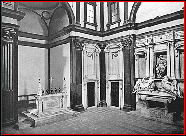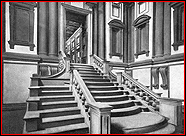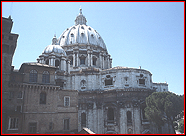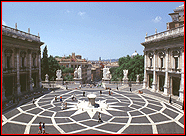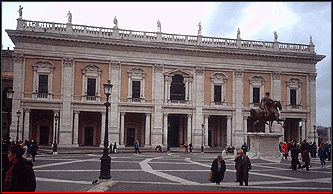Michelangelo Buonarroti
1475-1564
OVERVIEW
Talents
Michelangelo Buonarroti (1475-1564) is unique in the history of world art as the only man to attain the highest level in the three arts of painting, sculpture, and architecture. He was also an accomplished poet.
Commissions
From the time Michelangelo was thirty, he was regularly employed by popes. Most of his career was spent working in Rome on papal projects or in Florence on additions to the Medici family church.
Biographical Sources
The two main sources of biographical information about Michelangelo are Vasari's Lives (1550) and Condivi's Vita di Michelagnolo Buonarroti (1553). Vasari, a fellow Florentine, idolized Michelangelo and used him as an exemplar of Florentine disegno. Condivi, Michelangelo's pupil and admirer, conveyed Michelangelo's feelings of persecution and not being appreciated. His account included much detail about Michelangelo's projects.
YOUTH
Birth and Childhood
Michelangelo was born in 1475 at Caprese near Sansepolcro, which is near Arezzo and Urbino. As a former podestà (governor), his father stressed the family's respectability and discouraged his son's pursuit of an art career. Michelangelo was provided a humanist education initially, but when he was thirteen his father gave in and apprenticed him to the painter Ghirlandaio in Florence.
Training in Sculpture
It is undocumented as to how Michelangelo became an accomplished sculptor so early in his career, as demonstrated by his relief, Battle of Lapiths and Centaurs, which he completed when he was seventeen. According to Condivi's biography, he taught himself using borrowed tools. According to Vasari's biography, Michelangelo studied with Bertoldo di Giovanni, a sculptor of small bronzes who supervised a group of young sculptors at San Marco.
Living in the Medici Household
Michelangelo's being invited to live in the Medici household by Lorenzo the Magnificent was supposedly the result of Lorenzo's having seen a carving by him of the head of a faun.
Because Lorenzo's household and intellectual circle included many prominent Neoplatonists, this period is cited as having provided Michelangelo with a groundwork in Neoplatonism, which has been found to underlie some or all of his major art works.
Earliest Works
Michelangelo's earliest surviving works were small relief panels.
♦Battle of Lapiths and Centaurs, 1491-2. Michelangelo's Battle of Lapiths and Centaurs demonstrates his precocious ability to depict anatomically convincing figures in action.
♦Madonna of the Steps, 1491. The schiacciato carving of the Madonna of the Steps represents a stylistic antithesis of the vigorous high-relief carving of the Battle of the Centaurs.
EARLY CAREER, 1492-1508
Self-Directed Study and Travel, 1492-6
After Lorenzo's death in 1492, Michelangelo moved out and began a period of self-directed study and travel. He studied anatomy by dissecting corpses through a secret arrangement at the monastery hospital of Santo Spirito. During his early years he traveled and worked on relatively small commissions in Florence, Venice, and Bologna.
Rome, 1496-1501
During a five-year period in Rome from 1496 to 1501, Michelangelo carved the Bacchus and the Pietà. The latter brought recognition of his extraordinary talent.
♦ Bacchus, 1496-7. The Bacchus was commissioned as a garden decoration. The wine god is shown in an intoxicated state holding a bunch of grapes, which is being eaten by the satyr by his side. This work was rejected by its patron, Cardinal Raffaele Riario of the della Rovere family, who probably expected a more traditional depiction that followed classical precedents.
♦ Pietà, 1497-1500. In 1497, a French Cardinal, Jean de Bilheres, commissioned Michelangelo to sculpt his first Pietà. Although the Pietà subject showing the Virgin mourning her dead son was common in northern art, it was unusual in Italian art of this period. According to Vasari, after Michelangelo heard viewers attribute the Pietà to another sculptor when it was first displayed, he returned that night and carved "Michelangelo Buonarroti of Florence made this" on the band across the Virgin's chest. Realistic particulars like consistent scale (the Virgin is disproportionately large) and relative ages (she appears too young to be a grown man's mother) are sacrificed to create a timeless vision of grief on a lofty spiritual plane.
Florence, 1501-5
Michelangelo was commissioned to do a great deal of work during this period, beginning his lifelong pattern of promising more than he could do and leaving a trail of unfinished projects. A number of important works date from the period between his return to Florence in 1501 and his departure for Rome at the invitation of Pope Julius II in 1505.
♦David, 1501-4. Michelangelo's David, which was carved from an especially large stone that had been partially carved by another sculptor, was commissioned for a position on the north tribune of Florence Cathedral. The largeness of the hands and head probably reflect an attempt to compensate for the extreme viewing angle required by such an elevated position. After it was completed, city officials decided that it should be mounted lower so that the statue's great beauty could be enjoyed at closer range. A committee decided to place it on the platform next to the Palazzo Vecchio in the Piazza della Signoria. A replica now occupies its original place.
♦Doni Madonna, 1503-4. The Doni Madonna, which depicts the Holy Family, is Michelangelo's only surviving panel painting. It is praised for its bold colors, which are similar to those used in the Sistine Ceiling, and it is regarded as an extraordinary example of Florentine disegno.
♦Taddei Tondo, c. 1504. Various degrees of completion are revealed by the Taddei Tondo. The infant John the Baptist frightens the infant Jesus with his gift of a goldfinch, which alludes to the latter's future sacrifice.
♦Battle of Cascina, begun 1503. The city of Florence commissioned Michelangelo to paint the Battle of Cascina for the grand council chamber, the Salone dei Cinquecento, of the Palazzo Vecchio. Leonardo was commissioned to paint another battle scene on the adjacent wall. For unrelated reasons, both artists abandoned their work at an early stage: Leonardo completed a small portion of the fresco, and Michelangelo created only the cartoon and never progressed to the painting phase. We know these works only from preliminary drawings and copies made by other artists before the walls were frescoed over.
♦Bruges Madonna, 1503-5. Michelangelo carved a Madonna and Child for a church in Bruges in Belgium. The frontal presentation of the Madonna and the Infant Christ intensifies this work's monumentality and majesty.
Rome and Carrara, 1505-6
In 1505 Michelangelo traveled to Rome to work on an elaborate freestanding tomb for Pope Julius II. By the time Michelangelo succeeded in quarrying marble in Carrara and bringing it back to Rome, the Pope had re-focused his attention on two Vatican projects, the new St. Peter's and the Belvedere Court. After failing to receive payment for further work, an angry Michelangelo returned to Florence.
Florence and Bologna, 1506-8
In Florence Michelangelo began carving a large statue of Saint Matthew for Florence Cathedral. Although the Pope commanded Michelangelo to return to Rome, he refused to do so until pressured by city officials, who feared papal ire. Michelangelo presented himself to Pope Julius in Bologna, which the latter had just taken by military force. The Pope forgave him and commissioned a monumental bronze statue of himself, which was to remain in Bologna.
♦ Saint Matthew, 1507-8. Saint Matthew was commissioned as one of twelve statues of the apostles to stand on the buttresses of Florence Cathedral. Like most of Michelangelo's works, this figure was conceived in terms of a frontal view. The figure's expressive pose is well established although the figure is but a relief on part of the block.
♦Sculpted Portrait of Julius II (destroyed) 1507-8. Michelangelo cast an over-life-size portrait statue of Pope Julius II to commemorate Pope Julius' conquest. It was mounted in a niche on the façade of San Petronio in Bologna, which is well known in art history as the site of Jacopo della Quercia's relief panels around the portal. After papal authority was overthrown in Bologna a few years later, the portrait was melted down to make a cannon known for the pope as "La Giulia".
ROME, 1508-16
Events and Commissions
1508-12. In 1508 Pope Julius commissioned Michelangelo to paint the ceiling of the Sistine Chapel. This project had been proposed to him earlier in a letter dating to 1506.
1513-16. Pope Julius died in 1513 and his heirs revived the tomb project. Instead of being freestanding, the 1513 version was to be a wall tomb, smaller in size than the earlier version, but otherwise, similar to the original in many respects. During this period, Michelangelo worked on the figures of Moses, the Dying Slave, and the Rebellious Slave.
Art Works (1508-16)
♦Sistine Chapel Ceiling, Vatican, 1508-12. Michelangelo, who would have been advised by theologians on iconology, was allowed to change the subject and form of the Sistine-ceiling project from the type in which figures and scenes are contained within architecturally defined compartments like that of the ceiling of Raphael's Stanza della Segnatura to an illusionistic framework of architecture and figures framing Biblical scenes.
♦Dying Slave. The so-called Dying Slave is generally interpreted as being in a dream-like state. There is a partially carved monkey behind the figure, possibly referencing the concept of art aping nature.
♦Rebellious Slave. The Rebellious Slave struggles against his bonds. In combination, this figure and the Dying Slave have been interpreted as embodiments of activity and passivity. These figures have been paralleled to the ignudi of the Sistine ceiling, who hold garlands of oak leaves and acorns.
♦Moses. Michelangelo's figure of Moses is over twice life size. Because of its expression of passion and power, Moses is often paralleled to both Pope Julius and Michelangelo himself.
FLORENCE, 1516-34
Events and Commissions
1516. In 1516 Michelangelo was engaged by the new Medici Pope, Leo X, to collaborate with the architect Baccio d'Agnolo on a façade for San Lorenzo, the Medici-family church in Florence. Within two years Michelangelo had a new contract giving him sole responsibility for the architecture of the façade as well as for the sculpture.
In 1516 a third contract for the tomb of Julius II defined a smaller monument with half as many figures as the 1513 version and lengthened the time Michelangelo would be allowed to finish it to nine years. The Pope's influence had facilitated Michelangelo's obtaining such favorable conditions.
1517. In 1517 Michelangelo designed windows for the ground-story arches of the Palazzo Medici, which were filled in for security. The corner arches had originally formed a loggia.
1519. Following the deaths of two Medici governors of Florence, the pope's brother Giuliano de' Medici in 1516 and his nephew Lorenzo the Younger de' Medici in 1519, Pope Leo decided to commission a mortuary chapel containing tombs for them, as well as for their grandfather Lorenzo the Magnificent and his murdered brother, Giuliano. Consequently, the contract for the façade of San Lorenzo was canceled and Michelangelo was asked to work on the new chapel instead.
1519. The New Sacristy of San Lorenzo, which is better known as the Medici Chapel, was commissioned and begun.
1520-23. Michelangelo is thought to have worked on the four Slaves for Julius II's tomb between 1520 and 1523. During most of 1522 and 1523, the Medici family was less able to pressure him to work on their projects at San Lorenzo because the papacy was not occupied by a member of the Medici family. Consequently, Michelangelo probably spent more time on sculpture for Julius II's tomb during these years.
1523. The second Medici pope, Pope Clement VII, commissioned Michelangelo to design the Laurentian Library at San Lorenzo, and to continue working on the Medici Chapel there.
1527-30. After the Sack of Rome neutralized papal support of the Medici in Florence, Medici rulers fled from the city. During this period, Michelangelo worked as a military engineer designing fortifications for the city, which had established a Republican government with Nicolò Capponi as its governor. After the 1530 siege of Florence in which Emperor Charles V assisted Pope Clement in returning the Medici to power, Michelangelo, who was under a death threat for treason, went into hiding until he was pardoned by the pope.
1532. The della Rovere heirs decided to reduce the expense of the tomb by signing a new contract that only required Michelangelo to finish six of the statues. Michelangelo would be allowed two months a year by Pope Clement to work on its completion.
While on a trip to Rome, Michelangelo met the handsome young nobleman Tommaso de' Cavalieri, with whom he remained friends for the rest of his life.
Art Works (1516-34)
Most of Michelangelo's work during this period was concerned with architecture or tomb sculpture.
♦Four Slaves. The Four Slaves were intended for the 1516 version of Julius II's tomb. Because the sculptures were left in various stages of completion, they give a fascinating glimpse of Michelangelo's working methods. (Fragmentary works by great artists are more highly regarded today than in Michelangelo's time.)
♦Tomb of Giuliano de' Medici. The Tomb of Giuliano de' Medici includes an effigy of the deceased in a niche above a sarcophagus that supports figures representing Day and Night.
♦Tomb of Lorenzo de' Medici. The Tomb of Lorenzo de' Medici whose sarcophagus figures represent Dawn and Dusk, follows the same pattern as that of Giuliano's tomb.
♦ Medici Madonna. The nursing theme in the Medici Madonna can be found in several of Michelangelo's other depictions of the Madonna including his very early relief Madonna of the Steps.
♦ Victory. Around 1530, Michelangelo carved the Victory figure group, which exemplifies the figura serpentinata. A wreath of acorns on the main figure's head indicates that this work was intended for the tomb of Julius II, whose family name of Rovere means oak. After Michelangelo's death, this work was sold to Cosimo I and placed in the audience chamber, the Salone dei Cinquecento, of the Palazzo Vecchio.
ROME, 1534-64
Events and Commissions
1534-41. In 1534 Pope Clement VII asked Michelangelo to paint the altar wall of the Sistine Chapel, but the Pope died suddenly before it was begun. His successor, Pope Paul III, re-commissioned the painting whose subject was to be the Last Judgment. Michelangelo prepared the cartoon in 1535 and completed the painting in 1541. During this period, Michelangelo began his friendship with Vittoria Colonna, a highly cultured and devout widow and the granddaughter of Federico II da Montefeltro, the Duke of Urbino.
1537. Paul initiated the project to build the Piazza del Campidoglio in 1537 when he asked Michelangelo to move the statue of Marcus Aurelius to stand in front of the Palazzo Senatorio on a new base that would be designed by the architect. It is not known how much of the piazza and the façades of the buildings surrounding it that Michelangelo designed at this time.
1542-5. In 1542 Michelangelo entered a final agreement with the della Rovere family requiring only three statues by his own hand for the tomb of Julius II. The tomb was completed by 1545 and erected in San Pietro in Vincoli, a much more modest location than Julius II had planned. The original project was designed for St. Peter's. The four sculpted figures on the upper level were designed by Michelangelo but carved by others.
1542-50. Pope Paul commissioned Michelangelo to paint the side walls in the newly built Pauline Chapel of the Vatican.
1544. In 1544 a monumental staircase of Michelangelo's design was begun on the exterior of the Palazzo Senatorio as part of the building of the Piazzo del Campidoglio.
1546. The post of architect of St. Peter's fell vacant in 1546 after the death of Antonio da Sangallo the Younger who had been in charge since Raphael's death in 1520. Pope Paul made Michelangelo the new chief architect and supported his proposal to dismantle much of Antonio's work and return to the centralized conception underlying Bramante's original plan. The Pope also assigned Michelangelo to take over the building of his family palace, the Palazzo Farnese, which Antonio began 32 years earlier.
1551. Michelangelo designed a new staircase for the upper terrace of the Belvedere Court.
1561-63. The new façades for the two buildings that then faced the Piazza del Campidoglio were begun in the 1560s, the Palazzo Senatorio in 1561 and the Palazzo dei Conservatori in 1563.
1564. Michelangelo died in 1564 at the age of 89.
Art Works (1534-64)
In his later years, Michelangelo increasingly turned his attention to architecture. He sculpted mainly for himself.
♦Last Judgment, 1534-41. The Last Judgment demonstrates a significant evolution in style since painting the Sistine ceiling a quarter of a century earlier.
♦Brutus, 1540s. Michelangelo carved a bust of Brutus for Cardinal Niccolò Rodolfi, who wished to honor the republican spirit of the Florentine people. The bust's Roman subject and political theme are reflected by its similarity in form to a Roman bust. Michelangelo himself had supported the city's republican government during the 1527-30 interlude of independence from Medici domination.
♦Final tomb of Julius II, 1545. The final tomb of Julius II is barely a shadow of its original conception.
♦Pauline Chapel frescoes, 1542-50. For the decoration of the side walls of the newly finished Pauline Chapel, Pope Paul III commissioned scenes illustrating his namesake, the apostle Paul, and his earliest predecessor as Pope, the disciple Peter.
♦Florentine Pietà, 1547-55. According to Vasari, Michelangelo had intended to use the Florentine Pietà on his own tomb. The face of Nicodemus, who stands in the rear, is a self-portrait. The work was partially completed by Tiberio Calcagni.
♦Rondanini Pietà, begun 1556. Michelangelo began the Rondanini Pietà on his own initiative. He changed his mind about the composition and cut away all but a ghostly sliver of the Virgin and her dead Son. He worked on the sculpture in the last years of his life, yet it remained unfinished at his death.
Overview
Michelangelo did not work as an architect until he was in his forties. His work falls into two stylistic phases that parallel the two different periods and milieus in which he undertook his major architectural commissions.
Florentine Period
Michelangelo's architecture in Florence, where he worked from 1516 through 1534, primarily consisted of three sites at San Lorenzo.
This work established him as one of the founders of the style that has come to be called Mannerism. His irreverent use of classical forms was less of a breaking of rules than it was an attempt to add beauty and strength to structures by creating new arrangements of architectural elements.
Roman Period
Michelangelo's architectural work in Rome, which began at the death of Antonio da Sangallo the Younger and ended with his own death in 1564, was largely commissioned by popes Although this work demonstrated the persistence of many of the qualities present in his early work, it no longer exhibited the disturbing aspect of Mannerism.
Michelangelo's late work, which anticipated many elements of the Baroque style, was larger in scale and more unified around a focal point. In determining proportions, Michelangelo used his sculptor's eye and made features like crowning cornices in scale with the whole building rather than with just its upper story. Similarly, his use of the giant order brought pilasters into scale with the building's full height.
ARCHITECTURAL CHARACTERISTICS
General Qualities
A number of general qualities can be identified in Michelangelo's architecture.
●Optical approach. Michelangelo designed buildings optically, that is, on the basis of how they appeared rather than how they embodied preconceived design principles. This approach is also referred to as "pictorial." At times Michelangelo used full-scale wood models of parts of buildings. For example, he made a model of the corner of the cornice for the Palazzo Farnese, which was then raised into place to decide if it was better. This concept also explains why Michelangelo's designs changed so frequently during construction periods.
●Caprice. In regarding the eye as the final arbiter during the design process, Michelangelo felt unconstrained to follow the fundamental rules of Roman architecture. He rearranged classical motifs in striking and unprecedented ways.
●Dynamism. Michelangelo's architecture possesses an organic sculptural quality. His forms are fluid and energetic.
●Unity. Michelangelo conceived of buildings as unified, organic wholes in which the parts play dominant or subordinate roles. The parts are interlinked so that none can stand alone as discrete entities. Linear forms often intersect other parts. Michelangelo's giant-order columns, for instance, tie separate stories together. Devices like projecting the wall plane and massing ornamental forms focus attention at the center. Forms like panel surrounds or ceiling and floor panels are linked by similarities in design. Individual shapes are repeated on other forms.
●Tactile contrasts. The expression of oppositions takes numerous forms such as shallow spaces with deep recesses and crisp angles with curvilinear forms.
Frequently Used Forms
Despite stylistic changes over the years, Michelangelo's architecture displays certain forms repeatedly. Many of these forms were used on his first important architectural design, the façade of San Lorenzo.
●Wide and narrow bays. Michelangelo introduced variety and rhythm by alternating wide and narrow bays.
●Advancing and receding wall planes. Michelangelo used advancing and receding wall planes to endow his architecture with a more organic quality.
●Pier edges projecting at sides of pilasters/columns. The edges of the piers express the building's structural system.
●Interlacing of horizontal and vertical edges. Vertical lines break through horizontal features, producing grids of intersecting edges.
●Massing of ornament over doors. The massing of ornament at doorways unifies Michelangelo's structures by giving them strong focal points while adding an organic quality.
●Unorthodox window, door, and panel surrounds. Window, door, and panel surrounds were made up of unorthodox arrangements of classical forms and motifs.
●Colossal-order pilasters. In his later years in Rome, Michelangelo favored the use of giant-order pilasters.
Florence
Michelangelo's earliest important architectural work was commissioned by the Medici family for their family church of San Lorenzo in Florence.
♦Façade of San Lorenzo (not constructed), 1516-19. Michelangelo spent several years designing and quarrying marble for a façade of San Lorenzo before the project was canceled. Although this was his first major architectural project, many features that are characteristic of his mature architectural works can be seen on his model. The church's entrance facing still remains without a façade.
♦Windows in arches, Medici Palace, 1517. When Giovanni de' Medici became Pope Leo X in the early sixteenth century, the open arches on the ground story were filled in to improve security. Michelangelo was commissioned to design windows, which are the probable models of windows that were designed for the ground stories of palaces such as the Palazzo Pitti by Bartolommeo Ammannati and the Palazzo Farnese by Antonio da Sangallo the Younger.
♦Medici Chapel, San Lorenzo, begun 1520. Michelangelo's Medici Chapel is also called the New Sacristy because it forms a mirror-image counterpart to Brunelleschi's Old Sacristy. It is similar to the older structure in its plan, its use of pendentives, and its use of pietra serena, but it is different in having a coffered dome, rectangular windows, a two-story division of the wall below the pendentives, a two-part scheme of stone trim, and many unusual forms.
♦Laurentian Library, San Lorenzo, 1523-59. Giulio de' Medici commissioned Michelangelo to design a library for the Medici collection of manuscripts, which he had given to San Lorenzo. A ground-story vestibule contains stairs leading up to the second-story reading room. Due to the unusual design of the walls and the crowding of parts, the vestibule is considered one of Michelangelo's most Mannerist designs. The reading room follows the layout used at Michelozzo's Library at San Marco in Florence, in which lines of crosswise desks are illuminated by windows on the long sides, yet it differs in having a flat ceiling and no supports between the desks and central aisle.
Rome
In 1534 Michelangelo moved to Rome permanently and devoted most of his time to papal projects. In his later years, he devoted a larger proportion of his time to architecture. After the death of Antonio da Sangallo the Younger in 1546, Paul III commissioned Michelangelo to take over his work at the Farnese Palace and the Vatican.
♦Piazza del Campidoglio, 1537-64. Michelangelo began his long association with the construction of the Piazza del Campidoglio and its buildings when Pope Paul III asked him to move the statue of Marcus Aurelius to that site. In 1544 a new staircase was added to the Palazzo Senatorio. Work on the piazza continued slowly until Pope Pius IV funded the beginning of new façades of the Palazzo Senatorio and the Palazzo dei Conservatori in the 1560s.
♦St. Peter's, Vatican, 1546-64. After the death of Antonio da Sangallo the Younger, who had been the chief architect of St. Peter's since the death of Raphael, Michelangelo was put in charge of the project. He abandoned Antonio's axial plan and model and returned to a simpler variation of Bramante's apse-ended Greek-cross plan. Michelangelo's detailing of the outer perimeter consists of a rhythmic arrangement of paired pilasters that establish wide and narrow sections of walls. The edges of its vertical and horizontal members intersect on the cornice. The strong vertical lines direct the eye upward toward the dome and its lantern. The engineering of the dome's support system has been much studied, and its steeper-than-hemispherical proportions are the basis for similar designs in the Baroque period.
♦Parts of Palazzo Farnese, 1546-64. Pope Paul enlisted Michelangelo's assistance for the completion of his family palace, the Palazzo Farnese, which Antonio da Sangallo designed and worked on for over thirty years. Michelangelo changed the design of the cornice, using a far larger one whose scale reflected the palace's immense size. In the same vein, he enlarged the upper section of the entrance, making it more emphatic and ornate. Michelangelo brought a distinct character to Antonio's design calling for three-stories of superimposed loggias in the courtyard by changing the two upper stories: he filled in Antonio's second-story arches and set windows in the walls of the second and third stories.
♦Staircase for Palazzo Senatorio, Piazza del Campidoglio, 1544-52. In conjunction with building the Piazza del Campidoglio, Michelangelo designed a monumental double-ramped staircase for the Palazzo Senatorio, whose new façade was begun in 1561. Michelangelo's massive staircase and two-story pilasters conveyed the dignity and stability of Roman civic authority.
♦Staircase for Belvedere Court, Vatican, 1551. Pope Julius III commissioned Michelangelo to design a new staircase for the upper terrace of the Belvedere Court. The Pope's expansion of the Belvedere Villa had required the removal of Bramante's staircase, whose design is known from Serlio's Architettura.
♦Porta Pia, 1561-65. Michelangelo designed the Porta Pia for Pope Pius IV. Its function as a gate in the ancient Roman city wall was more decorative than defensive. It stands at one end of the Via Pia, which Pius IV also built, and faces inward toward the city.
♦Façade of Palazzo Senatorio, Piazza del Campidoglio, 1561-1616. In 1561 Michelangelo began a new façade for the Palazzo Senatorio, which had been built in the twelveth century. The 1544 addition of a prominent staircase and the rebuilding of a tower in the center gave the building a central focus that was especially appropriate for its central position at the closed end of the piazza.
♦Palazzo dei Conservatori, Piazza del Campidoglio, 1563-84. To stylistically update the Palazzo dei Conservatori in conjunction with the building of the Piazza del Campidoglio, Michelangelo designed a new loggia-fronted façade, which was unique in using trabeated construction for the building of a ground-story loggia. Colossal-order pilasters link the two stories into one, and freestanding columns introduce a dual scale of the orders. The same design was used for the Palazzo Nuovo, which was built across the piazza from it in the first half of the seventeenth century.
♦Santa Maria degli Angeli (formerly Baths of Diocletian), early 1560s. In the early 1560s, Pope Pius IV asked Michelangelo to convert part of the Thermae of Diocletian into the church of Santa Maria degli Angeli. Michelangelo's part in the design of the Certosa attached to the Church is a matter of speculation.



 Add Placemark
Add Placemark Go Back
Go Back 





